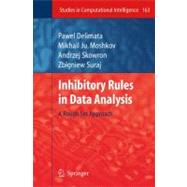
Note: Supplemental materials are not guaranteed with Rental or Used book purchases.
Purchase Benefits
What is included with this book?
| Introduction | p. 1 |
| Maximal Consistent Extensions of Information Systems | p. 9 |
| Main Notions | p. 11 |
| True Realizable Inhibitory Rules | p. 11 |
| Separating Sets of Attributes | p. 12 |
| Description of the Set U | p. 13 |
| True Inhibitory Rules | p. 18 |
| True Deterministic Rules | p. 18 |
| Information Systems with Binary Attribute | p. 18 |
| Structure of Ext[superscript 3](S) | p. 20 |
| Checking Membership to Ext[superscript 3](S) and Construction of Ext[superscript 3](S) | p. 21 |
| Description of Ext[superscript 3](S) | p. 21 |
| True Realizable Deterministic Rules | p. 24 |
| Information Systems with at Most One Non-binary Attribute | p. 24 |
| Structure of Ext[superscript 4](S) | p. 26 |
| Algorithmic Problems Related to Ext[superscript 4](S) | p. 27 |
| Conclusions | p. 29 |
| Minimal Inhibitory Association Rules for Almost All k-Valued Information Systems | p. 31 |
| Main Notions | p. 32 |
| Relationships between Rules and Inconsistent Equation Systems | p. 33 |
| Cardinality of Irreducible Inconsistent Equation Systems | p. 34 |
| Number of Irreducible Inconsistent Equation Systems | p. 37 |
| Construction of All Irreducible Inconsistent Equation Systems | p. 38 |
| Minimal Inhibitory Rules | p. 39 |
| Length of Minimal Inhibitory Rules | p. 39 |
| Number of Minimal Inhibitory Rules | p. 40 |
| Construction of All Minimal Inhibitory Rules | p. 40 |
| Conclusions | p. 41 |
| Partial Covers and Inhibitory Decision Rules | p. 43 |
| Partial Covers | p. 43 |
| Main Notions | p. 44 |
| Some Known Results | p. 44 |
| Polynomial Approximate Algorithms | p. 46 |
| Bounds on C[subscript min]([alpha]) Based on Information About Greedy Algorithm Work | p. 46 |
| Upper Bound on C[subscript greedy]([alpha]) | p. 48 |
| Covers for the Most Part of Set Cover Problems | p. 49 |
| Partial Inhibitory Decision Rules | p. 50 |
| Main Notions | p. 51 |
| Relationships between Partial Covers and Partial Inhibitory Decision Rules | p. 51 |
| Precision of Greedy Algorithm | p. 53 |
| Polynomial Approximate Algorithms | p. 54 |
| Bounds on L[subscript min]([alpha]) Based on Information About Greedy Algorithm Work | p. 56 |
| Upper Bound on L[subscript greedy]([alpha]) | p. 59 |
| Inhibitory Decision Rules for the Most Part of Binary Decision Tables | p. 59 |
| Conclusions | p. 62 |
| Partial Covers and Inhibitory Decision Rules with Weights | p. 63 |
| Partial Covers with Weights | p. 64 |
| Main Notions | p. 64 |
| Some Known Results | p. 65 |
| Polynomial Approximate Algorithms | p. 66 |
| Comparison of Standard Greedy Algorithm and Greedy Algorithm with Two Thresholds | p. 67 |
| Two Modifications of Greedy Algorithm | p. 68 |
| Lower Bound on C[subscript min]([alpha]) | p. 69 |
| Upper Bounds on C[superscript gamma subscript greedy]([alpha]) | p. 70 |
| Partial Inhibitory Decision Rules with Weights | p. 71 |
| Main Notions | p. 71 |
| Relationships between Partial Covers and Partial Inhibitory Decision Rules | p. 73 |
| Precision of Greedy Algorithm with Equal Thresholds | p. 75 |
| Polynomial Approximate Algorithms | p. 75 |
| Two Modifications of Greedy Algorithm | p. 76 |
| Bounds on L[subscript min]([alpha]) and L[superscript gamma subscript greedy]([alpha]) | p. 77 |
| Conclusions | p. 79 |
| Classifiers Based on Deterministic and Inhibitory Decision Rules | p. 81 |
| Decision Tables | p. 81 |
| Classifiers Based on Deterministic Decision Rules | p. 82 |
| Classifiers Based on Inhibitory Decision Rules | p. 83 |
| Results of Experiments | p. 84 |
| Conclusions | p. 86 |
| Lazy Classification Algorithms Based on Deterministic and Inhibitory Association Rules | p. 87 |
| Characteristic Tables | p. 88 |
| Information Systems | p. 88 |
| Deterministic Characteristic Tables | p. 88 |
| Inhibitory Characteristic Tables | p. 90 |
| Evaluation Functions | p. 91 |
| Algorithms of Classification | p. 91 |
| Results of Experiments | p. 93 |
| Conclusions | p. 96 |
| Lazy Classification Algorithms Based on Deterministic and Inhibitory Decision Rules | p. 99 |
| Decision Tables | p. 100 |
| Deterministic Decision Rules | p. 100 |
| Inhibitory Decision Rules | p. 101 |
| Algorithms of Classification | p. 102 |
| Results of Experiments | p. 104 |
| Conclusions | p. 105 |
| Final Remarks | p. 107 |
| References | p. 109 |
| Index | p. 115 |
| Table of Contents provided by Ingram. All Rights Reserved. |
The New copy of this book will include any supplemental materials advertised. Please check the title of the book to determine if it should include any access cards, study guides, lab manuals, CDs, etc.
The Used, Rental and eBook copies of this book are not guaranteed to include any supplemental materials. Typically, only the book itself is included. This is true even if the title states it includes any access cards, study guides, lab manuals, CDs, etc.